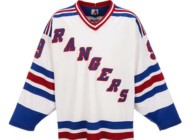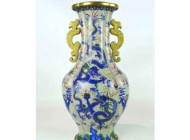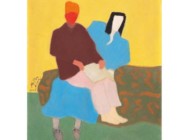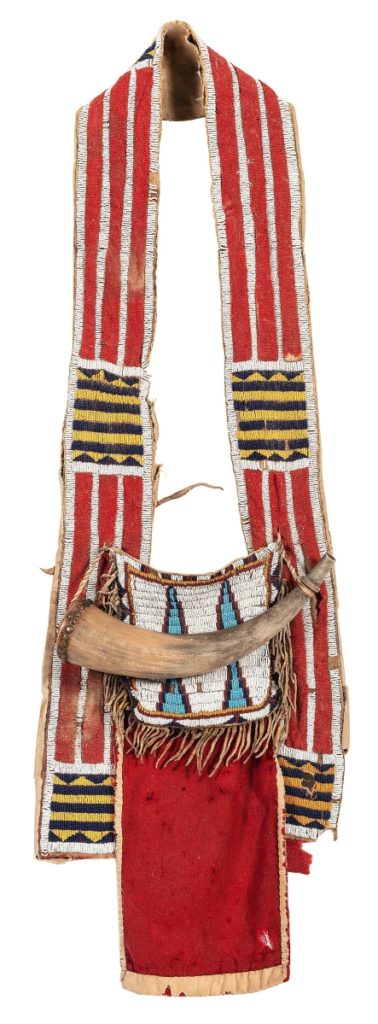
The sale was led by a group consisting of a Yankton Sioux beaded buffalo hide shot pouch and powder horn, measuring 39 inches overall, which surpassed its high estimate to bring $53,125.
Review by W.A. Demers, Photos Courtesy Hindman Auctions
CINCINNATI, OHIO – Native American art was the focus of Hindman’s April 15 auction comprising nearly 300 lots. Offered was material from the Paleo Indian period through 1930s, in categories of stone, beadwork, pottery and jewelry. Bidding for the auction, which totaled more than $1.1 million, was available in person at the Cincinnati salesroom, by telephone, online via Hindman’s Digital Bid Room and additional online bidding platforms.
The sale featured pieces from the prominent collections of John Baldwin, Marilyn Eber, Robert P. Hunter Jr and Barbara Hunter, Claude “Henry” Withers, Bruce and Claire Montgomerie and Gary and Carl Lewis Druckman. Top billing went to a group consisting of a Yankton Sioux beaded buffalo hide shot pouch and powder horn, measuring 39 inches overall, which surpassed its high estimate to bring $53,125. From the third quarter of the Nineteenth Century, the pouch was sinew-sewn and backed with canvas, its strap consisting of vertical beaded lanes in white, alternating with lanes of red trade wool, accented by five boxes with horizontal lanes in colors of cobalt and yellow. Edged with fringe and decorated with triangular elements beaded in colors of translucent burgundy, cobalt, marigold and sky blue against a white background, the pouch was accented by a longer strip of red trade wool, edged with cotton cloth. Hindman noted similar examples are found within the Hirschfield collection and the Ten Kate collection.
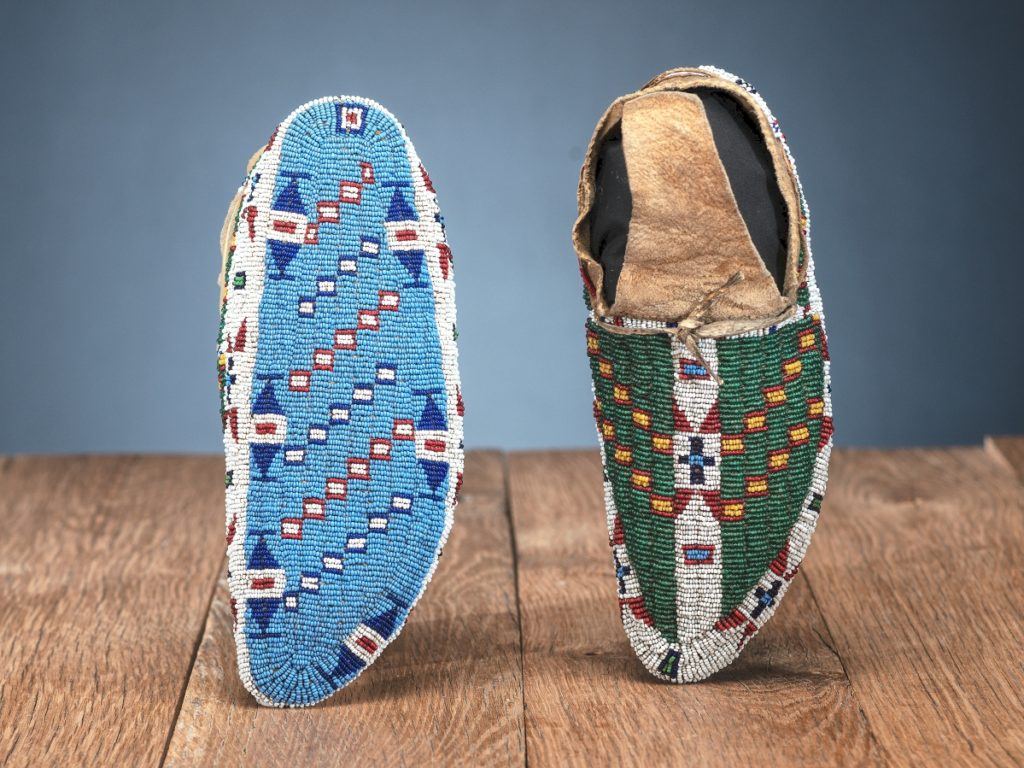
A new auction record was set for a pair of Sioux fully beaded buffalo hide moccasins following a heated bidding war that took them way past their estimate of $1/2,000 to sell for $40,625, the highest price ever achieved for a pair of fully beaded moccasins.
Two collections that had the best performance in the sale were those of Claude “Henry” Withers and the John Baldwin Trust. Rare copper items from the Withers collection received significant interest from bidders, packing Hindman’s Cincinnati saleroom and achieving top prices. Revered collector and author John Baldwin’s collection also shone, with lots such as a grizzly bear claw necklace selling for $37,500 against an estimate of $20/30,000. The necklace featured 27 claws spaced with hand painted and padre beads and was collected from the University of Iowa’s Theatrical Department. Baldwin is well-known in the collecting world, and his books on Native American and frontier-era weaponry are considered essential reading for those serious about the category.
Textiles from the collection of Bruce and Claire Montgomerie also were among top performers, with a Nineteenth Century Navajo woman’s Second Phase pattern blanket soaring past its estimate of $8/10,000 estimate to sell for $37,500. A Navajo Moki pattern weaving was another noteworthy sale, realizing $18,750.
The second highest selling lot in the sale was a copper dagger from the collection of Claude “Henry” Withers. Bidders enthusiastically competed for the dagger from the late Archaic period, which climbed well past its estimate of $10/15,000 to sell for $43,750. Featuring a symmetrically designed blade, one of the largest examples of this rare artifact type, measuring 11ý inches, the dagger’s tapered blade had a central raised dorsal ridge along the front and flat surface on the back. The base of the blade was decorated with curvilinear finials, accentuating the elegant design.

From the John Baldwin Family Trust, this grizzly bear claw necklace sold for $37,500 against an estimate of $20/30,000. The necklace featured 27 claws spaced with hand painted and padre beads and was collected from the University of Iowa’s Theatrical Department.
Catalog notes state that in David Lutz’s book, The Archaic Bannerstone, he discusses the dating of copper breastplates, daggers and lizards as being an Archaic artifact. These objects are found in conjunction with bannerstones (which are solely an archaic tool). He states, “These rare artifacts are often thought of as Hopewellian when in fact they are Late Archaic…Most convincingly is that both artifacts are always found on sites possessing bannerstones.”
Also catching bids from the Withers collection were two copper breastplates, selling for $7,500 each. They were both from the late archaic period, 5000-1000 BCE, found in Spencer County, Ind.
A new auction record was set for a pair of fully beaded moccasins. A heated bidding war took them way past their presale estimate of $1/2,000 to sell for $40,625, the highest price ever achieved for a pair of fully beaded moccasins. These vibrant shoes are sinew-sewn and beaded using colors of red, white-heart, greasy yellow, translucent green, white and light and dark blue.
Selling for $13,750 was this steatite biconical tube pipe dating from the early Woodland period, 800-100 BCE, found in Jefferson County, Tenn.
From the third quarter of the Nineteenth Century, Cheyenne beaded buffalo hide saddle bags realized $16,250 against an estimate of $6/8,000. Thread and sinew-sewn, each body was beaded using colors of pony trader blue, cobalt, greasy yellow, white and red white-heart. They were adorned with medallions with red trade wool and tin cones placed above beaded panels and sported a thick fringe
A circa 1900 Navajo Third Phase pattern rug, woven of hand-spun wool in colors of indigo, red, dark brown and cream was further decorated with diamond shapes with feathered edges containing Spider Woman crosses. From the collection of Bruce and Claire Montgomerie and measuring 56¾ by 73 inches, it brought $15,000, more than twice its high estimate.
More treasures emerged from the John Baldwin Trust. A steatite biconical tube pipe dating from the early Woodland period, 800-100 BCE, was found in Jefferson County, Tenn. A large example (12ý inches), elegantly carved from green steatite, the pipe featured two conical tubes tapering into a central raised bar. It sold for $13,750. An Adena flint ridge blade, from 800 BCE-1 CE, found in Licking County, Ohio, was 5-5/8 inches long and was bid to $9,375; while an eastern pipe tomahawk blade with brass inlay from the Eighteenth Century featuring a hand-forged blade decorated with sun and scrolling elements took $8,750.
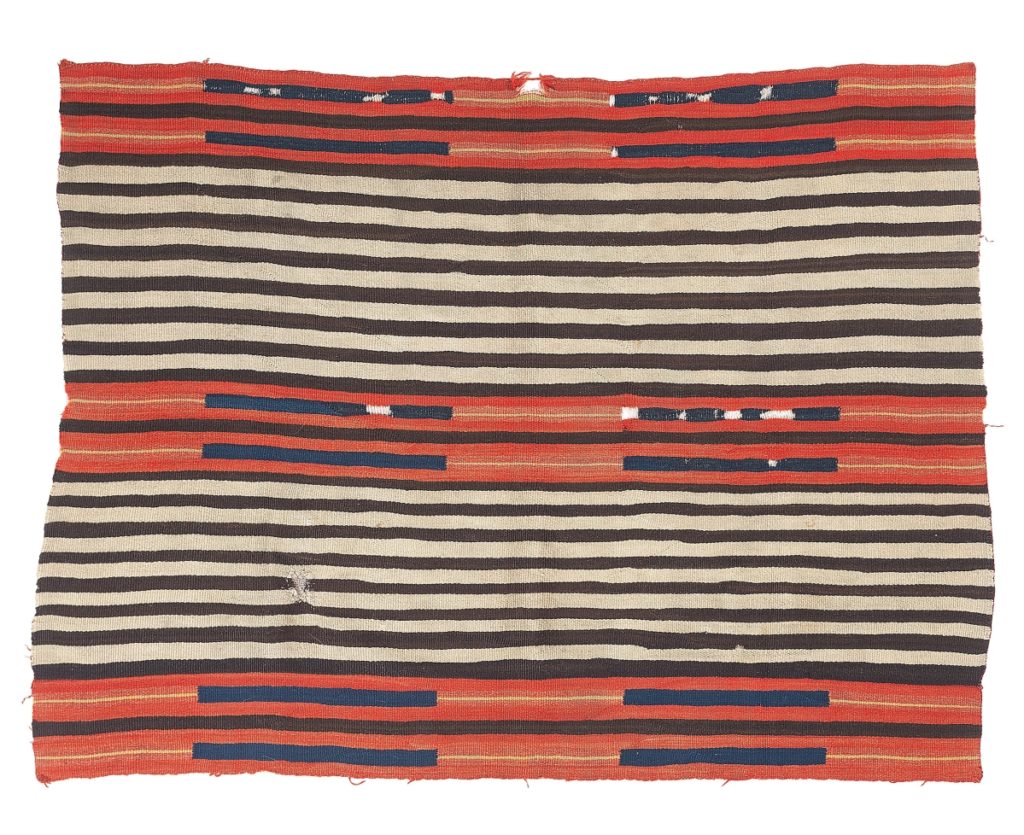
Among textiles from the collection of Bruce and Claire Montgomerie, a Nineteenth Century Navajo woman’s Second Phase pattern blanket soared past its $8/10,000 estimate to sell for $37,500.
From the fourth quarter of the Nineteenth Century, a pictorial Apache beaded hide jacket went out at $10,625. It was fashioned from softly tanned hide, thread and sinew-sewn with pictorial elements of eagles and crosses on its sleeves, and was back beaded using colors of dark blue, red white-heart, white, greasy yellow and translucent green.
A Zia polychrome pottery olla from the fourth quarter of the Nineteenth Century was of substantial size, 17 inches high by 18 inches in diameter. Painted with four Zia birds placed in the crests and troughs of a rainbow, it left the gallery at $8,750.
Miniature gift baskets that descended through the family of Jessie Cavannaugh with labels identifying early basket makers was another standout selection. A group of Twentieth Century Pomo miniature gift baskets was a strong example, selling for $7,500 against an estimate of $800-$1,200.
Prices given include the buyer’s premium as stated by the auction house. For information, www.hindmanauctions.com or 513-871-1670.















